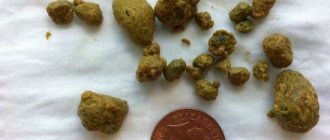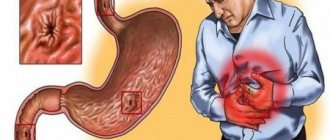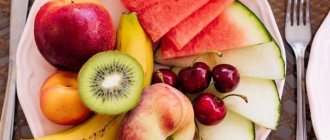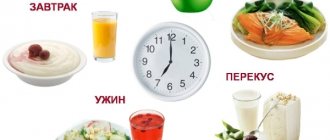Basic principles of the diet
A diet for Crohn's disease must be followed throughout your life, being somewhat stricter with yourself during exacerbations. Dietary nutrition allows, in most cases, to avoid surgical treatment or at least postpone it to a later date.
Proper food is the only way to improve the quality of life of patients.
The principles of the diet are not complicated, but require punctual adherence. The basis of the diet is table No. 4 according to Pevzner. The goal is to exclude all foods that irritate the intestines.
Construction rules:
- complete rejection of spices, aromatic herbs and flavorings, especially all varieties of pepper;
- exclusion of raw plant fiber in the form of thermally unprocessed vegetables and fruits;
- exclusion of fatty foods;
- exclusion of unprocessed lactic acid products, casseroles and cheesecakes are allowed in small quantities;
- lean meat and fish in boiled, minced form;
- eating soft food without rough lumps, so that the food is well mixed and processed by intestinal juices;
- compotes and juices must be homemade, weak or diluted with water;
- refusal of any industrially produced canned food, including vegetables, dairy and fruit;
- the maximum amount of salt is 8 grams or a full teaspoon;
- a minimum amount of raw fruit is allowed (on the first day - half, then 1-2) with soft pulp without skin - apple, apricot, peach, plum only local, during the season of their natural ripening;
- complete exclusion of alcohol and smoking, they aggravate the course of the disease, shorten the duration of remission and increase the frequency of relapses;
- refusal of honey and bee products that have high allergenic properties;
- eating small portions 5-6 times a day, with the last meal should be 3-4 hours before bedtime;
- food should be warm - not cold or hot, in order to avoid spasmodic contractions of the intestines caused by temperature exposure;
- drinking at least 1.5-2 liters of clean water, evenly throughout the day, preferably several sips every 30-40 minutes.
The diet option depends on which part of the intestine is affected the most. If the ileum is affected, the restrictions are minimal, but if the stomach or duodenum is involved in the autoimmune process, you will have to eat only pureed and not particularly tasty food for a long time. The main thing you need to understand is that your level of health directly depends on nutrition.
The diet for each person is compiled individually, taking into account personal preferences. You need to listen to your body, start eating new foods in tiny portions, no more than a tablespoon. If the body reacts well, then gradually the amount can be increased, but prohibited products should never be used.
Oatmeal
Kennedy says oatmeal is a breakfast option because oats contain a lot of soluble fiber, which absorbs water and moves slowly through the digestive tract—as opposed to insoluble fiber, which is difficult to digest and can irritate the gut. Gluten-free oats can also be used (look for the gluten-free label). Here's a recipe from her that requires no cooking:
Composition of the product
- ½ cup old fashioned oats
- ½ glass of your favorite milk
- ¼ cup yogurt (optional)
- 1 tsp. vanilla extract
- 2 tsp. honey or maple syrup
Combine all ingredients in a sealed mason jar, stir and refrigerate overnight.
Products
| Recommended Products | Not Recommended Products |
|
|
Nutrition for Crohn's disease. Ready diet
Crohn's disease (CD) is an autoimmune inflammatory disease that can affect different parts of the intestinal tract, but most often the inflammatory processes are localized in the ileum and large intestine. The causes of the pathology are not fully understood, and treatment methods are limited to relieving symptoms and prolonging the state of remission (quiet course of the disease).
In addition to drug therapy, patients with CD must adhere to a strict diet during periods of exacerbation and a less restrictive diet during long-term remission. Poor nutrition in Crohn's disease can result in increased inflammation and complications.
Crohn's disease: what to remove from your diet
Diet and CD symptoms are closely related. Some foods can provoke an exacerbation of pathology.
What foods are dangerous for the gastrointestinal tract in Crohn's disease:
- Spicy foods containing mustard oils, capsaicin, allicin, gingerol, piperine (different types of peppers, ginger, mustard, horseradish, garlic);
- Alcohol;
- Caffeine-containing drinks, such as soda and coffee (tea also contains a significant proportion of caffeine, so if you have CD, avoid strong brewing);
- Wheat varieties, rye, oats and barley (contraindicated if there is a history of gluten intolerance);
- Food prepared by frying in vegetable, sunflower oil or other fats;
- Products high in fat;
- Sweets (confectionery products with the addition of large amounts of sugar, sweets, ice cream, etc.);
- Canned food;
- Flavor enhancers (seasonings);
- Pickles (pickled or pickled cucumbers, mushrooms, etc.).
Patients with CD must understand and accept the importance of diet. Frequent exacerbations of Crohn's disease lead to worsening pathogenic processes, which may result in complications.
Diet for Crohn's disease: how to eat
In addition to a number of restrictions, the diet for Crohn's disease includes an extensive list of healthy foods that contain important microelements and nutrients necessary to maintain body function and weight.
Fatty acids are an integral part of the menu, but their valuable qualities depend on the type of fat. It has been proven that to reduce inflammation in the intestines, it is enough to include omega-3 fatty acids in your daily diet. At the same time, omega-6s harm the gastrointestinal tract and aggravate the general condition.
Undesirable products:
- Raw chicken and quail eggs;
- Fatty poultry and red meat;
- Bakery products;
- Butter;
- Different types of cheeses.
- Healthy foods containing omega-3:
- Low-fat fish varieties;
- Linseed oil;
- Nuts (rough food can damage the mucous membrane and walls of the gastrointestinal tract, so you can eat nuts in ground form).
Omega-3 is believed to be found in large quantities in fish oil capsules.
The more diverse the bacterial environment in the intestines, the higher the chances of prolonging the state of remission in CD. Therefore, fiber is recommended for people with this type of autoimmune disease. At the same time, it has not been clinically proven that appropriate foods in the diet for Crohn's disease help improve gastrointestinal tract functions.
The role of a healthy and nutritious diet
The nature of the course of CD depends on a person’s habits, lifestyle and diet. If you do not follow the recommendations of gastroenterologists and ignore your diet, the load on the organs of the digestive tract will increase. In response to this, there will be an increase in inflammatory reactions in the gastrointestinal tract. As a result, complications may arise:
- Stricture (this term refers to the narrowing of part of the intestine).
Strictures lead to scarring on CT scans and inevitable changes in the mucosa. The consequence of this phenomenon can be chronic constipation and obstruction over time. In severe cases, the patient requires immediate assistance from surgeons to remove the problem area of the gastrointestinal tract. Such patients are subsequently assigned a disability, and their quality of life is significantly reduced.
Linear integrity disorders can appear in different parts of the intestinal tract, including the anal canal. The more extensive and deeper the lesions are, the more likely intraintestinal blood loss and anemia are as a consequence.
This term implies the formation of new holes in the walls of the gastrointestinal tract.
This is a serious complication resulting from non-compliance with the recommended diet menu for Crohn's disease. In the intestinal tissues, purulent formations appear, limited to a thin capsule.
Diet is a prerequisite within the therapeutic process. With frequent failures in nutrition, the disease recurs, and then unwanted complications appear, one of which is cancer.
To maintain the desired balance in the microflora of the intestinal tract, in addition to the right foods, probiotics (especially effective for eliminating diarrhea) and prebiotics are recommended to patients. Antibiotic medications suppress inflammation in the intestines and are also used to treat Crohn's disease.
Fecal transplantation is another treatment option that involves replacing the bacterial content of the intestine. The technique involves transplanting foreign feces into the CT with the correct balance of bacteria.
Exacerbation of Con's disease and diet
Increased symptoms of inflammatory reactions are the first sign that a patient with CD has begun an exacerbation period. A gentle diet should be an immediate response to the complication of symptoms.
The menu for Crohn's disease on exacerbation days includes water soups (vegetables with the addition of lean chicken), vegetable purees, natural compotes and/or rosehip tinctures. It is recommended to exclude cereals and solid foods.
With the onset of remission, the diet expands.
Ready menu for every day
Despite a number of limitations, the menu for Crohn's disease can be nutritious, healthy and varied. It is important that the diet consists of the maximum amount of vital microelements, including protein foods.
Tasteless prepared food can cause loss of appetite, weight (including muscle mass) and a deterioration in the patient’s general condition, including depression and apathy. Therefore, nutritionists advise monitoring not only the quality of food products for CD, but also paying attention to taste characteristics. Decorations in the form of greenery and original presentation will help improve the patient’s appetite.
Day 1 (Monday)
- Oatmeal porridge, ground and boiled in water with a small amount of additives; jelly made from berries and/or fruits.
- Fruit pudding.
- Chicken soup (you can add shredded rice, but exclude potatoes); weak green tea.
- Oat cookies.
- Steamed beef cutlets. Salted pumpkin or potato puree with water.
Day 2 (Tuesday)
- Rice casserole with pumpkin. Fruit compote.
- Baked apples.
- A fresh vegetable salad. Fruits.
- Vegetable puree soup or rabbit broth with meatballs. Fruit drink without sugar.
- 1 percent kefir. Biscuit.
Day 3 (Wednesday)
- Steamed fish. Baked or boiled cauliflower. Tea without sugar.
- Banana.
- Rich vegetable broth and chicken breast puree. Berry jelly.
- Sea buckthorn compote.
- Buckwheat or rice balls (baked or steamed). Kissel or tea.
Day 4 (Thursday)
- Liquid rice porridge. Morse.
- Low-fat kefir. Cookies with figs.
- Chicken fillet soup.
- Tea/compote.
- Boiled buckwheat with fish balls.
Day 5 (Friday)
- Liquid millet porridge. 2 boiled eggs.
- Cupcake with raisins.
- Ear. Morse.
- Kissel.
- Crushed potatoes and meat/fish soufflé.
Day 6 (Saturday)
- Cottage cheese casserole. Cocoa.
- Fruit and berry puree. Tea without sugar.
- Pumpkin broth with eggs and buckwheat or Ratatouille eggplant soup.
- Rose hip decoction.
- Semolina porridge, boiled turkey fillet.
Day 7 (Sunday)
- Banana rice pudding. Fruit juice or tea.
- Natural yogurt, cottage cheese.
- Lean rabbit broth with broccoli.
- Low-fat three-day kefir. Crackers.
- Baked carrots and cauliflower. Fish souffle. Compote.
When planning a diet for a child with Crohn's disease, it is important to monitor the variety of foods. It is not recommended to repeat dishes more than once every seven days.
Menu for exacerbation of Crohn's disease
To restore gastrointestinal functions and stabilize the condition, a 7-day regime of gentle nutrition is recommended.
In the first 48 hours, you should eliminate solid foods and go into fasting mode. Low-fat kefir or tea is allowed. For diarrhea, you can eat baked carrots or apples.
On days 3-5 of the diet, light soups and broths containing poultry meat, softened crackers, steamed omelettes, jelly, and water-based porridge are gradually introduced into the diet.
On days 5-7, the diet includes stewed vegetables, baked apples, eggs, and rice.
link:
Source: https://kronkolit.pro/pitaniye-pri-bolezni-krona-gotovyy-ratsion/
Sample menu for the week
This menu is for informational purposes only. The diet is agreed upon with the doctor in accordance with the characteristics of the disease.
Essential Nutrient Ratio:
- carbohydrates – at least 250 grams;
- proteins – 100 grams;
- fats – as agreed with the attending physician, more than 70 g, vegetable, dairy and animal.
The minimum calorie content of the daily diet is 2100 kcal. After an exacerbation and concomitant weight loss, the energy value may be slightly increased.
| Days | Breakfast | Dinner | Dinner |
| Monday | steam omelet from 2 eggs a slice of yesterday's bread weak black tea with lemon | recycled broth soup with meatballs; mashed potatoes; berry jelly | cheesecakes baked in kefir; fruit compote |
| Tuesday | semolina porridge in water with added milk; baked apple; rosehip decoction | fish soup with pieces of boiled carcass; steamed fish cutlet; fruit jelly on agar-agar; | chicken soufflé; mashed potatoes; weak black tea |
| Wednesday | buckwheat porridge in water with added butter; weak tea with lemon | secondary chicken broth with pasta; meat soufflé; fruit compote | baked apple; biscuits; acidophilus milk |
| Thursday | baked zucchini; a piece of boiled fish; rosehip decoction | vegetable soup; pureed rabbit casserole; fruit jelly | slimy rice porridge; natural juice diluted with water |
| Friday | mashed potatoes with added butter; steamed veal cutlet; berry jelly | pureed vegetable soup with meatballs; vegetable puree; berry juice | fruit pudding; biscuits; weak black tea |
| Saturday | puree from boiled vegetables; a piece of boiled chicken; natural fruit juice diluted with water | vegetable soup; steamed rabbit soufflé; rosehip decoction | steam omelette; yesterday's bread; weak black tea |
| Sunday | casserole of cottage cheese and berries; crackers; tea | secondary pureed chicken broth; steamed veal cutlet; berry juice | boiled buckwheat porridge; fruit jelly |
Three meals a day is not enough, since the maximum break between meals is 4 hours. It is advisable to add a second breakfast and afternoon snack; you can use the following dishes:
- biscuits with compote or jelly;
- baked fruit pulp;
- berry jelly;
- acidophilus milk with day-old bread;
- boiled egg;
- mashed porridge with water;
- vegetable puree, best from carrots and apples;
- carrot casserole;
- zucchini in milk sauce;
- secondary broth with crackers.
With Crohn's disease, nutrition should be treated like medicine, taking strictly prescribed meals by the hour.
What can you eat during CD remission?
During remission, CD patients must be careful about the amount of nutrients and fluids they have lost during the ongoing acute phase of diarrhea. To replenish lost nutrients, it is recommended to consume foods rich in fiber. These include:
- Finely ground whole grains
- Dried and fresh fruits and vegetables,
- Rice,
- Oats,
- Potato.
Wheat, milk, corn and yeast are less tolerated by patients with CD. Many people with CD suffer from lactose or fructose intolerance. It is necessary to undergo a special medical examination to exclude such a problem. If you are lactose intolerant, you will have to remove dairy and fermented milk products from your daily menu.
Yogurt
Yogurt and other fermented foods (foods that have already been fermented), such as kefir and sauerkraut, contain probiotics. Probiotics are beneficial bacteria found both in some foods and in our intestines. Healthy microflora plays a very important role in the treatment of inflammatory bowel diseases. Eating foods that contain live and active cultures helps maintain optimal levels of beneficial bacteria in our gastrointestinal tract.
When buying yogurt, kefir, fermented baked milk and the like in the store, pay attention to labels like “live bacteria”, “active lactobacilli”, etc. Also, products without added sugar will be more beneficial for your intestines. If you cannot live without sweets, a small amount of fruit or honey can help in this matter.











